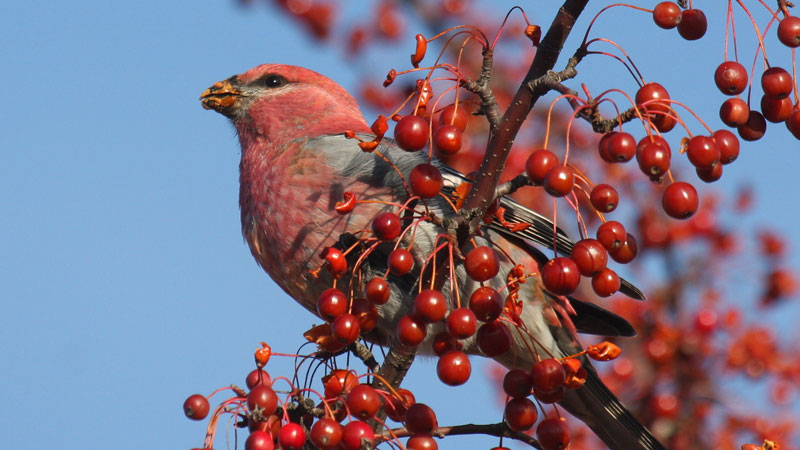Pine Grosbeak
Pinicola enucleator Linnaeus (1758)
Photo: © Jay McGowan

Appearance:
Adult males are raspberry-red on the head, breast, sides, back, and rump, with blackish-brown flight feathers; grayish chin and under eyes; lores and indistinct eyeline blackish; wings with 2 white wingbars, and white edges on tertials and secondaries, leading edges of primaries reddish to grayish; uppertail coverts dark gray, edged reddish; tail long and moderately notched; lateral and posterior underparts grayish. Adult female slightly smaller, and it and first-year birds (both male and female) with head, rump and sides of breast to flanks yellowish to bronze, plumage otherwise gray including more extensively in lores to area below eye.
Size: L 9″
Shape: Medium-sized, deep-chested, deep-bellied, broad-necked bird with a fairly long notched tail and short, deep-based bill with a curved culmen.
Both Sexes: Two broad white wingbars on blackish wings (upper wingbar may be hidden); broad white edges to tertials and secondaries; blackish bill.
Adult Male: Variable shades and extent of pinkish-red to red to orangish-red on the head, back, breast, and sometimes below (see Subspecies); rest of body gray.
Adult Female: Body mostly gray with olive, bronze to orangish or reddish-brown on head and rump (sometimes a hint on breast).
1st Year: Like adult female (Sept.–Mar.); in 1st summer (Apr.–Aug.), male can have a few pink or reddish body feathers.
Juv: (June–Sept.) Mostly brown with buffy wingbars.
Natural History:
Pine Grosbeak inhabits subarctic and boreal forests from eastern Canada to western Alaska. It also occurs in coniferous forests of western mountain ranges and in coastal and island rain forests of Alaska and British Columbia. Feeds primarily on a variety of spruce and pine buds and the seeds of mountain ash, box elder, and ash. During irruptions it can also be quite common in villages, towns and state forests with planted crabapples. Will also occasionally visit platform or hopper feeders to snack on sunflower seeds, particularly during the winter in northern parts of its range.
Taxonomy:
Pine Grosbeak Pinicola enucleator enucleator
-> Scandinavia to C Siberia
Pine Grosbeak Pinicola enucleator kamtschatkensis
-> NE Siberia
Pine Grosbeak Pinicola enucleator sakhalinensis
-> Sakhalin and Kuril Is., N Japan
Pine Grosbeak Pinicola enucleator flammula
-> coastal S Alaska and W Canada
Pine Grosbeak Pinicola enucleator carlottae
-> Queen Charlotte Is. (off W Canada)
Pine Grosbeak Pinicola enucleator montana
-> inland SW Canada to WC USA
Pine Grosbeak Pinicola enucleator californica
-> E California
Pine Grosbeak Pinicola enucleator leucura
-> inland W, C Alaska to E Canada and N New England (USA)
There are 9 subspecies worldwide; 5 subspecies breed in North America: P. e. flam- mula, P. e. leucura, P. e. carlottae, P. e. montana and P. e. californica. Subspecies P. e. kamtschatkensis is a casual vagrant to the western Aleutian Islands and Pribilofs. The bills of subspecies found in North America are shorter, broader, and deeper, with ssp. leucura in the East the broadest and deepest.
P. e. leucura (cent. AK–n.e. BC east to NF–CT) variably sized, m. breast and flanks pale red to red, varying individually with no consistency geographically; P. e. mon- tana (cent. BC–AZ and NM) large, m. breast dark red, flanks mostly gray; P. e. californica (e. CA) medium-sized, m. breast dull red, flanks mostly gray; P. e. flammula
(s. cent. AK–n.w. BC) medium-sized, m. breast and flanks bright red; P. e. carlottae (w. cent.–s.w. BC is.) small, m. breast and flanks dark red; P. e. kamtschatkensis (vag. to w. AK) medium to small, m. breast and flanks bright red.
Object of study:
Flight call variations and genetics.
Flight Call:
Usually described as tee-tee-tew, or resembling calls of Greater Yellowlegs but actually highly variable geographically depending on subspecies.
Taiga
Western
California, Pacific Northwest, Rocky Mts, Queen Charlotte groups
Eurasian
Irruptions:
The Taiga ssp. is an infrequent winter visitor often only irrupting in some numbers south of the boreal once every 4-7 years; it irrupts less frequently than other boreal finches, and its flights seldom penetrate as far south. Only during exceptional winters does the Pine Grosbeak become conspicuous, and then only locally. The Tiaga ssp. leucura is by far the most irruptive and can rarely occur as far south as Kansas and Virginia. In western mountains and coastal forests this finch apparently does not irrupt much and when it does it is largely only thought to involve ssp. flammula found along the coast of British Columbia northward to Alaska and ssp. montana found in the Rockies –The latter subspecies only irrupting to valleys in the foothills of the Rockies.
Irruptions Winter 2020-21: Taiga ssp. will irrupt, in at best, very small numbers into the border areas of the northeastern United States winter 2020-21. Likely a bit more common in the upper Great Lakes areas than the northeastern states.



